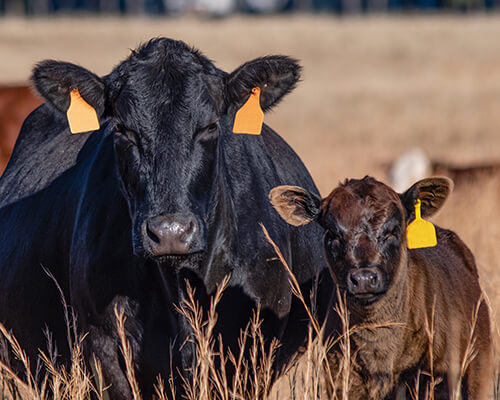What research says about optimizing replacement heifers
Feb 17, 2020

Developing replacement heifers for the breeding herd is one of the major challenges facing many beef producers. Optimum reproductive performance and lifetime productivity of a cow are clearly tied to proper nutritional management of replacement heifers during growth and development of structure and reproductive function.
Research has shown that the lifetime productivity of beef females can be increased by calving heifers at two years of age. This practice will improve the profitability of the beef operation by offsetting the costs of feed, labor and investment in raising replacements. To produce the maximum pounds of calves in her lifetime, a cow must calve each year starting as a two-year-old. Research from Oklahoma shows that true-heifers calving at two years of age produced an extra 330 pounds of calf on a lifetime basis over heifers calving at three years of age.
For heifers to reach puberty at 14-15 months of age, they must be adequately grown, but not over conditioned. Three factors associated with puberty in the replacement heifer are weight, age, and breed. Weight is thought to be the major determining factor affecting puberty in heifers at 14-15 months of age. Larger, later maturing breeds reach puberty at an older age.
Producers who have the most control over weight gain in their cattle should establish target weights at which heifers are to be bred and develop a feeding program to allow heifers to reach that goal in good condition. Replacement beef heifers should attain 65 to 70 percent of their potential mature weight by the time they are bred. This would mean that heifers should gain an average of 1.25 to 1.75 pounds per day from weaning to first breeding or 250 to 350 pounds during the first winter (depending on breed). For most breeds and crosses, heifers should weigh from 650 to 850 pounds at breeding time.
Mismanagement through over or under feeding during the critical phases will adversely affect lifetime productivity. Energy intake beyond needs for structural and muscular growth in heifers may cause problems regarding their potential of milk production. Research has shown that negative relationships between maximum probable producing ability of dams and milk production in offspring do exist.
Replacement beef heifers should be bred three weeks prior to the breeding of the mature cow herd since heifers require a longer period of time to begin cycling and show heat after calving than mature females. Heifers bred before the main cow herd will calve earlier in the season and should be cycling normally by the time the main cow herd is being bred the following year, provided adequate nutrition and management are in place. If heifers are to be good lifetime producers, they must show heat and conceive early in the breeding season. A breeding season of 45 days should be adequate for well grown heifers. Pregnancy check heifers and cull those that are open.
Have more questions? Stop by your local Co-op for more information.
Research has shown that the lifetime productivity of beef females can be increased by calving heifers at two years of age. This practice will improve the profitability of the beef operation by offsetting the costs of feed, labor and investment in raising replacements. To produce the maximum pounds of calves in her lifetime, a cow must calve each year starting as a two-year-old. Research from Oklahoma shows that true-heifers calving at two years of age produced an extra 330 pounds of calf on a lifetime basis over heifers calving at three years of age.
For heifers to reach puberty at 14-15 months of age, they must be adequately grown, but not over conditioned. Three factors associated with puberty in the replacement heifer are weight, age, and breed. Weight is thought to be the major determining factor affecting puberty in heifers at 14-15 months of age. Larger, later maturing breeds reach puberty at an older age.
Producers who have the most control over weight gain in their cattle should establish target weights at which heifers are to be bred and develop a feeding program to allow heifers to reach that goal in good condition. Replacement beef heifers should attain 65 to 70 percent of their potential mature weight by the time they are bred. This would mean that heifers should gain an average of 1.25 to 1.75 pounds per day from weaning to first breeding or 250 to 350 pounds during the first winter (depending on breed). For most breeds and crosses, heifers should weigh from 650 to 850 pounds at breeding time.
Mismanagement through over or under feeding during the critical phases will adversely affect lifetime productivity. Energy intake beyond needs for structural and muscular growth in heifers may cause problems regarding their potential of milk production. Research has shown that negative relationships between maximum probable producing ability of dams and milk production in offspring do exist.
Replacement beef heifers should be bred three weeks prior to the breeding of the mature cow herd since heifers require a longer period of time to begin cycling and show heat after calving than mature females. Heifers bred before the main cow herd will calve earlier in the season and should be cycling normally by the time the main cow herd is being bred the following year, provided adequate nutrition and management are in place. If heifers are to be good lifetime producers, they must show heat and conceive early in the breeding season. A breeding season of 45 days should be adequate for well grown heifers. Pregnancy check heifers and cull those that are open.
Have more questions? Stop by your local Co-op for more information.